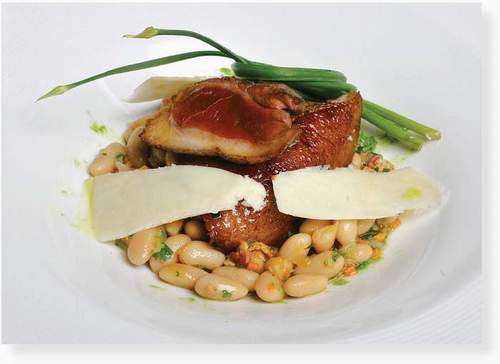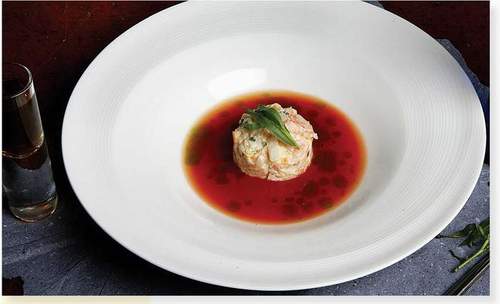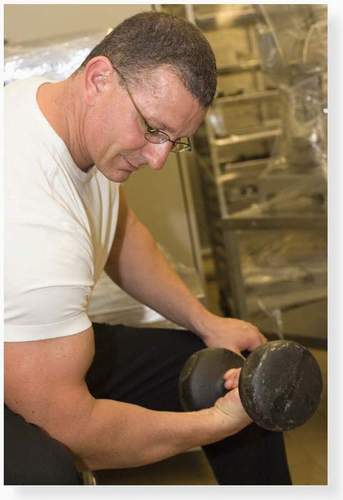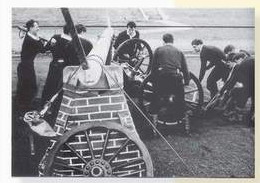Mission: Cook! (21 page)

Remove the crab cakes and let them rest briefly.
PRESENTATION
Place two of the whole claws or thighs in the center of each plate and place the crab cakes on top of them. Make a circle of the asparagus vinaigrette around the crab and arrange 3 or 4 of the asparagus tips in the vinaigrette on each plate. Drizzle the lemon vinaigrette over the crab cakes. Garnish the plate with kosher salt, freshly ground black pepper, and drizzled extra virgin olive oil.
SERVES
6
FOR THE WHITE BEAN RAGOUT
1 cup cannellini beans
1 tablespoon olive oil
4 ounces chopped raw bacon
1 leek stalk, white part only, diced small
1 carrot, minced
1 celery stalk, finely chopped
6 garlic cloves, minced
Salt and freshly ground black pepper
1 teaspoon balsamic vinegar
½ cup chicken stock
2 tablespoons chopped parsley
4 tablespoons Parmesan cheese
2 ounces (4 tablespoons) unsalted butter
1 ounce truffle oil
FOR THE DUCK
2 tablespoons salad oil
3 large duck breasts
Salt and freshly ground black pepper

PREPARATION AND COOKING TIME (ESTIMATES)
| Rehydration of cannellini beans | overnight |
| Cleaning leeks/prep time for ragout | 30 minutes |
| Cooking and assembly time for ragout | 40 minutes |
| Prep time for duck | 5 minutes |
| Cook/rest time for duck | 20 minutes |
| Slicing duck and plating | 10 minutes |
| Total estimated time | 24 hours plus |
| 1 hour 45 minutes |
Cover
the beans with water in a bowl or a pot and soak them overnight. Drain and rinse them. Place in a pot with enough water to cover them, bring to a boil, then simmer until just tender, about 1 hour. Drain, reserving the cooking liquid.
Preheat the oven to 400 degrees.
Place the olive oil in a large oven-safe sauté pan. Cook the bacon until browned. Add the leeks, carrot, celery, garlic, salt, and pepper. Cook for about 8 minutes, stirring occasionally.
Add the drained beans, vinegar, chicken stock, and 1 cup of the liquid from the beans. Place in the oven and cook for about 30 minutes. Allow the oven heat to reduce to 375 degrees. Pull out of the oven, then add the parsley, Parmesan cheese, butter, and truffle oil. Correct the seasoning with salt and pepper as needed.
In a heavy skillet over high heat, add the oil. Season the duck breasts with salt and pepper and place in the pan, skin side down. Sear for 3 to 4 minutes, or until golden brown. Turn over and cook for another minute.
Take the duck out of the pan, place on a baking sheet, and place in the oven for 6 to 8 minutes at 375 degrees, or until desired doneness. Let the duck rest before slicing.
PRESENTATION
Spoon the beans in the middle of each of 6 plates. Slice the duck breasts in half (each serving will be half of a duck breast). Then slice each half in ¼-inch slices and place over the beans. Drizzle with truffle oil.
A Note on Leeks
The root word of blanch means “whiten.” “Blanch"âthe cooking term that means to cook briefly in hot waterâis derived from the process of scalding nuts, such as almonds, to remove the skin and expose the white part underneath. Cooks aren't the only people who blanch things. Gardeners, farmers, and Mother Nature also blanch vegetables by shielding them from the sun, thereby keeping parts of the plant white. In the case of cauliflower, the process occurs naturally to an extent because of its natural covering of leaves. The stalks of leeks are buried in sand to keep them white. The result: lots of sand in leeks that must be removed before cooking. Soak them in a bowl of cool water to let the sand drop to the bottom. You may have to repeat the process a few times to get the leeks thoroughly clean.
SERVES
6
6 large cucumbers, peeled
10 large ripe tomatoes, diced large
1 jalapeño pepper, seeded
1 large onion, diced
2 celery stalks, diced
Juice of 2 lemons (the juice from each will be used separately)
Two 1½-pound lobsters, cooked and broken down
1 mango, peeled and diced small
1 papaya, peeled, seeded, and diced small
1½ cups crème fraïche
2 tablespoons chopped chives
Salt and freshly ground black pepper
2 tablespoons rice wine vinegar
3 tablespoons chopped chives
PREPARATION AND COOKING TIME
30 minutes to prep the dish
24 hours to extract the gazpacho liquid
I love recipes that can surprise you with their complexity and their simplicity at the same time. This one draws virtually all of the texture out of what you think gazpacho is supposed to be like, reducing it to its most essential flavors, yet it takes more than a full day to prepare.

Chop
four of the cucumbers, the tomatoes, jalapeño, onion, celery, and add the juice of one of the lemons in the food processor for 10 to 15 seconds. Place the mixture in cheesecloth and tie. Place the bundle in a large strainer over a con
tainer. Let rest overnight with a weight on top of the cheesecloth so the liquid will drip into the container. (One way of doing this is to nest a stainless-steel bowl, which fits into the strainer, on top of the cheesecloth bundle, and put a jar or can into the bowl as the weight.)
Take the cooked lobster and chop into ½-inch pieces. Remove the seeds from the two remaining cucumbers and dice. To make the lobster salad, combine the lobster and cucumber with the mango, papaya, crème fraïche, juice of the remaining lemon, chopped chives, salt, and pepper.
Squeeze all the excess liquid out of the cheesecloth and discard the solids. To the liquid add salt, pepper, and rice wine vinegar.
PRESENTATION
Place portions of cold lobster salad in the middle of each plate. Drizzle with the gazpacho. Garnish with chopped chives.
SERVES
6
FOR THE POTATOES
4 large Yukon gold potatoes, peeled and quartered
4 ounces (8 tablespoons) unsalted butter
4 ounces (½ cup) sour cream
1 ounce (
1
/
8
cup) chopped chives
4 ounces cooked chopped shrimp
FOR THE TUNA
8 cups olive oil
1 tablespoon freshly ground pepper
2 tablespoons fennel seeds, coarsely ground
2 tablespoons coriander seeds, coarsely ground
Six 6-ounce tuna fillets
2 tablespoons (
1
/
8
cup) kosher salt
1 cup shaved fennel
Juice of 1 lemon
2 tablespoons olive oil (from the oil used to poach the tuna)
Salt and freshly ground black pepper
1 cup micro fennel greens
Fennel fronds
Fleur de sel (a sea salt; see Note)
EQUIPMENT
A deep fryer
A ricer
Boil
the potatoes until soft in enough salted water to cover. Run the potatoes through a ricer and mix with the butter, sour cream, chives, and chopped shrimp. Keep warm.
Heat the olive oil in a deep-sided pot or deep-fryer to 180 degrees. Mix together the ground pepper, fennel seeds, and coriander seeds. Place the ground spices on a plate and press the tuna into the spices to coat.
Drop the tuna into the heated oil and cook for 5 minutes. Remove each portion from the oil carefully with a slotted spoon onto paper towels.
Toss the shaved fennel with lemon juice, oil, and salt and pepper.
PRESENTATION
Place the potatoes in the middle of the plate. Top with the tuna and place the shaved fennel on top of the tuna. Drizzle with the olive oil in which the fish was cooked. Toss the microgreens together with the fennel fronds and place on top of the shaved fennel. Sprinkle with fleur de sel.
A Note on Fleur de Sel
Fleur de sel is a gray-colored salt crystal hand-harvested in the Camargue region of France near Provence. Only the top layer of salt is gathered from pans of seawater.
A
S A CHEF, I CAN TELL YOU, EACH AND EVERY ONE OF US WANTS TO BE
the best. It's the human way. Our ambition to achieve excellence is rekindled anew every few moments, whenever we face a new tray or bowl or cupful of ingredients. It is in our nature both to conform to the traditions in which we have been schooled, and to search tirelessly for new ways to make them different, to change them, to improve and improvise and build our repertoires, and maybe to come up with something extraordinary. The universal appeal of eating in restaurants is to taste perfected dishes, the perfectly seared steak, the perfectly fired chicken, the most ethereally light soufflé, the most perfectly balanced crème brûlée. The universal appeal of cooking is someday to leave your unique and indelible mark upon the profession, to create a dish or a style that will be forever enrolled in the canon. That is why we worship at the altar of flavor.
POINT AND COUNTERPOINT
Competing in the most dangerous sport in the world
and frank talk on how best to eat
I
N STRIKING OUT TO ACHIEVE BALANCE IN YOUR DIET, IT IS IMPORTANT
not only to learn about your personal taste cravings and palate but also to know your own body.
I have taken a certain pride and interest in being fit and in good health since I was a young man. My father was a professional soccer player and I had an early inclination toward sport. I played soccer and rugby, and at about age thirteen, I met a man whose example has inspired me since, a Welsh gym instructor named David “Dye” Jones. Dye was a great motivator and a great teacher of leadership, both in words and by example. He started me lifting weights and I trained religiously with him, and with his son. David Jones, Junior, two years my senior and also called Dye, was a tremendous athlete who served with distinction in the Air Force and played rugby professionally for the Salisbury club. They instilled a work ethic and a sense of discipline in me that I still carry and rely on every day.
In 1988, I hit my peak physically when I competed for the Royal Navy Command of Portsmouth in the Annual Field Gun Competition at the Royal Tournament in London. If you are not a native of the British Isles there is an excellent chance that you have never heard of this revered institution, but it is a brutally grueling sporting competition that is assayed only by fanatics, and may rightfully live up to its reputation as the toughest team sport in the world.
The origins of the field gun competition hearken back to a legendary engagement in the Second Boer War in South Africa in 1899. The British were under siege and outnumbered in the town of Ladysmith, sorely pressed by the Dutch Transvaal Burgher Army, a nasty bunch to be sure. Anchored off Cape Town were HMS
Powerful
and HMS
Terrible
(in those days they really knew how to name ships). The commanders knew that the long guns on board, especially the devastating twelve-pounder field guns, might tip the balance in favor of the Ladysmith garrison. The guns were dismantled, shipped as far as possible by light rail, then by oxen cart, but the final stage was only navigable on

Big guns come from wielding the meat malletâ¦and curls, of course.
foot over very difficult terrain. The sailors from the naval brigade strained their guts and fortitude to the limits of human endurance to wrestle the hardware and guns, some of which weighed more than eight hundred pounds, over in-hospitable topography and an impassable chasm over which they rigged a wire traveler, to come to the rescue of the forces at Ladysmith and win the day. Her Majesty, Victoria Regina, personally thanked the men for their superhuman efforts.
The object of the modern field gun competition for teams of Navy sailors is to re-create this historic event over an elaborate obstacle course that represents the original terrain. It starts with a five-foot-high âhome wall' over which the equipment is hauled in the first leg of the race, called the “run out.” The 120-pound wheels, the gun carriage, and the vintage 12-pounder gun itself must be manhandled over the wall. The gun barrel alone weighs a slippery nine hundred pounds. From here it's up a steep ramp and across a twenty-eight-foot chasm, which must be crossed on a wire assembly by all, down a ramp, and through a hole in the opposing wall. Then the gun is assembled and three rounds are fired at the “enemy.”
The second section is called the “run back.” The gun carriage and barrel must be hefted back over the enemy wall in one piece. Its combined weight is in excess of 1,250 pounds. Once the last man is over the wall and across the chasm, the rig is collapsed, a process not unlike toppling two telephone poles, and three rounds are fired in a “rear guard” action.
This culminates in the “run home,” which means forcing everything and every man through a hole in the home wall, getting the wheels and the pins on the assembly in seconds, and ending in a final flat-out sprint to the finish line.
It takes eighteen men a side, working with split-second timing, clockwork precision, and unshakable teamwork, to achieve the course. In my day, men from Portsmouth, Devonport, and the Fleet Air Arm competed, and enthusiasts from all over England would come to cheer us on.
I was a “wheel man"; Wheel Man #4, to be precise. I was stationed on the HMS
Maxton,
a sweeper up in Scotland, when I was drafted for the Portsmouth Field Gun Crew in 1988. This was a prestigious appointment and pleased me no end, but the level of physical and mental toughness required was a shock to the system, to say the least. We were dropped into a parallel universe of extreme physical exertion. We would arise at six a.m., eat, then run. We ran in the ocean, ran in the heat and rain and mud and sand, ran uphill and uphill (I honestly don't ever remember running downhill). We ran with logs and sandbags strapped to our shoulders, and then we trained with the gun itself, over and over and over and over again. Our uniforms consisted of heavy black pants, gaiters, and a white tunic. As a wheel man, I was responsible for slinging a 120-pound wagon wheel over my shoulder, running like Man o' War, and swinging like Tarzan with it over the battlefield, and variously slapping it on or pulling it off of the assembly as we attacked the course. I padded both my shoulders with foam padding and piles of gauze bandages before each session, but the wheel inflicted in-numerable welts and bruises that just would not be denied.
To compete successfully in field gun, each competitor must have the strength of a rhinoceros, the lung capacity of an Olympic sprinter, the stamina of a locomotive, and the determination of a crazed madman. In the original adventure, the men of the
Powerful
and the
Terrible
took days to cross the wicked landscapes of South Africa. In the field gun competition, the entire course must be traversed in less than four minutes or you are disqualified. My crew routinely recorded runs in less than three. The field gun competition is about as close to real war as you can get in sport, and men have suffered smashed bones, bloody gashes, shredded tendons, even death on the grounds of the Royal Tournament. We trained incessantly prior to the matches, with a

Above left: My picture in the Field Gun competition program

Above: Robert, Wheel Man #4 in Portsmouth Field Gun competition; that's me at center with my backside to you
manic single-minded dedication and discipline. No matter how fit you thought you were, nothing could prepare your body for the sheer pain of the contest itself.
One care that I was able to leave behind during this period of time was worrying about what I was going to eat. We ate everything in sight. Our training tables seemed to consist of anything and everything we could lay our hands on. I would start the day with an archetypal English breakfast of eggs, bacon, sausages, bread and butter, and tomatoes, all broiled and piled high. That opening salvo would prime the engine to run beautifully, as long as it was further fed by a minimum of five to six full table-busting meals over the course of the rest of the day. We ate proteins, starches, and sweets indiscriminately, con-stantly hungry for anything that would provide calories. We took to carrying whole roasted chickens around with us in case of emergencies; sharks used to tell their children scary stories about us; small animals and birds scattered at our approach.
This story is illustrative in terms of thinking about one's body type and personal physical makeup when looking at the big dietary picture. I was at what I would consider to be my maximum capacity for physical exercise in those days. I exercise and keep to a pretty busy schedule today, but if I ate every week what I ingested in a typical week back then, I would either
become sick or, if I could manage to stick to it, would eventually weigh five hundred pounds.
The health of the body is inextricably linked with the foods we choose to put into it. This seems a matter of common sense. Yet, today, in this ten-thousandth year or so of human civilization, eating for health and fitness seems more of a conundrum than ever before, especially in the Western world.
If you are desperately searching for a system of eating that will give you unbridled health and eternal slimness, and that will create an irresistible gravitational pull to the opposite sex, just sit down at your computer, call up a search engine, and type in the word “diet."
There, that was easy, wasn't it?
As you sit and consider the literally millions of entries that flash before your eyes, many of which flatly contradict one another, you can begin to scratch the surface of the scope of the problem.
I would posit that as the universe of dieting theories, food fads, processed snacks, fast foods, health gurus, nutritional trends, and break-through studies expands, so do our collective waistlines. We suffer from a limitless menu of food choices, not only in terms of dishes and ingredients but of an astonishing availability of food kinds and combinations, but we have no regard for rational or recognized systems of culinary thinking; plates ordered in “family friendly” restaurants arrive in serving sizes of staggering, absurdist proportions. Portion sizes have become a running joke: “The food isn't that great, but they sure give you plenty of it!” We live among an embarrassment of culinary riches, whilst we struggle, awash in a sea of food gimmickry and of revolutionary diet plans that promise to whack off anywhere from ten to thirty pounds a week, without ever seeming to ask, at least in their screaming headlines, where those extra pounds came from in the first place.
One key concept has been lost, and it can be summed up in one word:
balance.
It would be remiss of me to just quote you the word “balance” without mentioning a second word that is as linked to the concept of achieving balance in your diet as is the word “cause” to “effect” and, with due deference to Mick Jagger, that word is
satisfaction.
Balance and satisfaction are the point and counterpoint of sensible eating.
The concept of balance goes back at least as far as the Greeks, who espoused in all things moderation as the path to health and happiness. In a
perfect world, we would grow hungry, we would eat a variety of foods as close to their natural states as possible, and once we were
satisfied,
we would stop and go for a walk. Balance has been achieved when your body tells you that it has been properly satisfied. If we could learn to feed properly and listen to our bodies' messages, there would be no need for starvation diets, or diets that insist that we gorge ourselves exclusively on carbohydrates
only,
or on veggies or fruits
only,
or on fats and proteins
only,
or diets that seek to effectively eliminate one food category, such as sugar or fat or salt.
Foods taste good together for a reason. There is an innate wisdom of the body that
knows
what is good. This wisdom can be recognized consciously and can be cultivated, if we only decide to pay attention to it. When the healthy body
*
is fed properly, it responds with a message of health and well-being, of
satisfaction,
not with conflicting messages of discomfort or bloating, of stunned, immobilized, overpacked fullness, of acid reflux and indigestion, of lingering ill-temper and bad disposition or, over time, of unhealthy weight gain, bone density loss, eating disorders, or food addictions.